This week’s Weekly has my review of the excellent “Lines of Thought” at the PMA, a show of working drawings by masters of the Indian miniature genre. Below is the copy and here’s the link to the art page. And for more photos, see my flickr.
It’s a Small World After All
A collection of Indian miniature paintings accentuates the creative process.
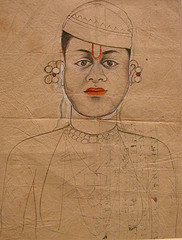
A Young Goswami, Late 19th – early 20th century
India, Rajasthan, Nathadwara
Opaque watercolor on paper
13 1/2 x 10 1/4 inches (34.3 x 26 cm)
Bequest of Dean Walker, 2006
If you’ve ever wondered how Indian miniature paintings are made, “Lines of Thought” in the William P. Wood Gallery 227 at the Philadelphia Museum of Art will intrigue you.
The 30 pieces on view from the Dean Walker Collection are mostly working drawings which date from the 15th century to the early 20th century from various royal workshops in Northern India.
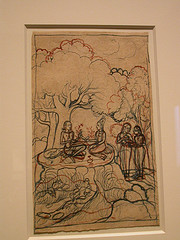
Laila visiting Majnun in the Wilderness. 18th c. Persian tale of Majnun who is insane with love for Laila. He’s gone to the wilderness to be alone. He’s ematiated from not eating. Majnun is the symbol of the soul suffering in his quest for God. Both Sufi Islam and Bhakti Hinduism have this suffering in quest of God theme.
For those familiar with the genre, the motifs will be familiar-portraits of kings; a palace scene; scenes of the Hindu gods Krishna and Vishnu; elephant, camel and horse portraits.
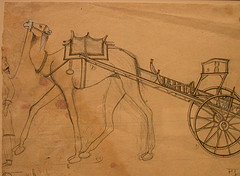
Design for a camel cart, circa 1800
But there are a few surprises too-a gorgeous finished drawing of a maid holding a royal baby; the engineering plan details of a camel cart; a botanical study of a fig, probably commissioned by a British visitor to India; a beautifully drawn plan for an elephant headdress.
Because the show is so much about the process-there are notations about colors and other artistic choices, as well as pentimenti (the ghostly erasures where the artist got it wrong the first time)-the entire exhibit is imbued with an engaging vulnerability. Observing the early struggle in the works is a revelation and dispels the notion this art was perfect from start to finish.
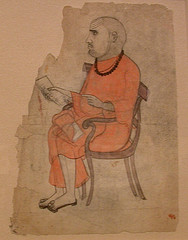
Holy Man seated on a Regency Style Chair. 1825-50/ Devotee of Shiva. Instead of sitting on the floor, he’s sitting on the chair. This denotes his status during the British period.
Piece after piece shows how much work was involved. In fact they were so labor-intensive that some of these drawings were used repeatedly-copied over and over to make new works that were identical or nearly identical. In one case a depiction of a horse and rider has been made anew-without the rider. In another case a fat king in the original drawing has been changed into the thin son of the king in another.
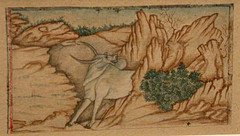
Taurus: A Wild Bull, Page from Kitab-i-Sa’at., astrological treatise from early 17th Century.
Several of the drawings look almost modern for their line quality, which is heavier than any line in a finished work. Laila Visiting Majnun in the Wilderness, for example, a depiction of a heartsick lover who seeks solace in the wilderness, has two sets of lines-red and black-both of which seem put down quickly as if to sketch in the composition. It’s shocking to think of an Indian miniature being sketched quickly since the finished works have an extreme precision that evokes a slow and ponderous building of one considered decision after another.
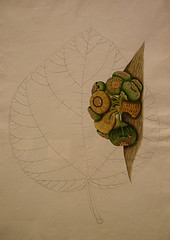
Fruit and Leaf of a Fig Tree, 1795-1800. Before photographs, British commissioned images of local flora and fauna.
The wall text is generous with details about the influence of Mughal invaders, the British occupation (suddenly Indian kings are sitting on Regency chairs) and European painting (frontal portraits replace the usual profiles). A Young Goswami, from the late 19th or early 20th century, is a great example of an early frontal portrait.
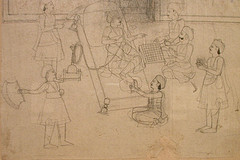
A Prince of Jaipur Playing Chess. 1780-1800 This one is an example of a pin-pricked drawing used for transfer. Copying was common practice. This central figure is thinner than the what was apparently in the original….the son, thinner than the father.
This is the first time the Dean Walker Collection has been shown, and the exhibit is in tribute to Walker, who died last year, and was the PMA’s senior curator of European decorative arts and sculpture. Fueled by his love of the process of creation, Walker began a personal collection of these works-in-progress which he then gave to the museum. The show and the collection are great gifts to the public.
“Lines of Thought: Indian Drawings From the Dean Walker Collection”
Through Nov. 26. Philadelphia Museum of Art, William P. Wood Gallery 227, second fl. 26th St. and the Pkwy. 215.763.8100.









